83 - Communicating Risk
from Theme 3: - Communication
Published online by Cambridge University Press: 05 June 2019
Summary

- Type
- Chapter
- Information
- Cambridge Handbook of Psychology, Health and Medicine , pp. 375 - 378Publisher: Cambridge University PressPrint publication year: 2019



